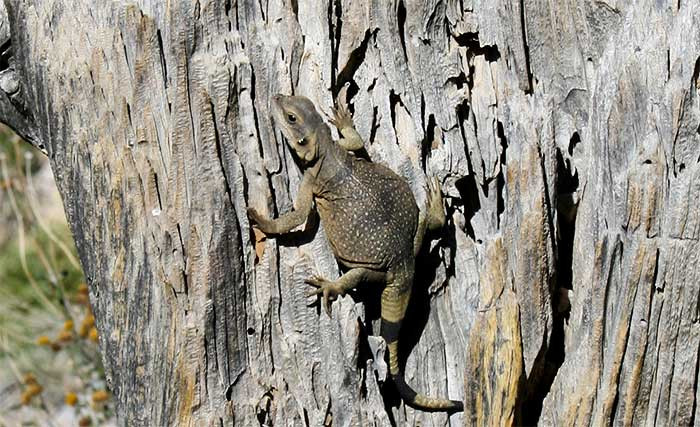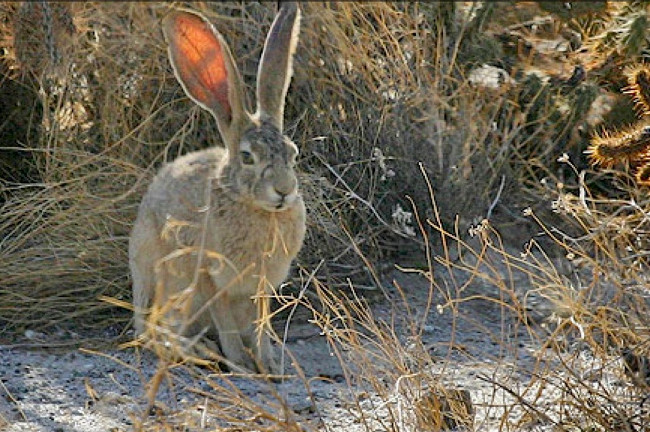Great hot escape of animals in the desert
Most desert animals develop complex and sophisticated mechanisms that help them solve the problem of heat and lack of water between harsh environments.
According to Desert USA, lack of water is a vital issue for all desert creatures, including animals and plants. However, animals face larger problems because they are more vulnerable to heat than plants. Animal species are in direct contact with temperature through radiation from the Sun and indirectly through heat transfer from the substrate (soil and rock).

Chuchwalla reptiles live in the dry desert of the southwestern United States.(Photo: Desert USA).
Biological processes in animal tissue can only take place within a relatively narrow temperature range, called the range of thermal neutralization. When the temperature is beyond this range, animals are easy to die. Daily temperature in the desert may be outside the neutral temperature range during 4-5 months of the year. Combined with water scarcity, the life of desert animals becomes extremely fragile.
Avoid heat
Techniques to avoid heat of desert animals are very rich. Some birds, such as Phainopepla, are shiny black elongated birds with slender crests, reproducing in the spring when the weather is relatively cool, then migrating from the desert to cooler areas in higher places. along the Pacific coast. Costa hummingbird, a desert bird with purple head and throat, begins to breed in the late winter, then leaves the desert in late spring. Many other birds work mainly a few hours before the Sun goes down, then rest in a cool shade for the rest of the day. Some species such as flycatcher work throughout the day but always park in the shade.

Desert rabbits in the southwest of the United States develop large ears to release heat.(Photo: Desert USA).
Many animals (especially mammals and reptiles) only work at dusk and dawn. Other animals work perfectly at night when the temperature drops. Bats, snakes, copper rats and large mammals like foxes and skunks are nocturnal. During the day, they sleep in caves or cool niches.
Some small desert animals such as reptiles, insects and amphibians dug burrows beneath the soil or sand to avoid high temperatures in the desert surface. In particular, the round tail squirrel (Xerospermophilus tereticaudus), a mammal that operates during the day, enters a dormant state when the day becomes too hot and the plants wilt dry. They will sleep during the hottest time of the summer. Desert toads sleep on the ground until the summer rains fill ponds. At that time, they will rise above the ground, spawn, lay eggs, and also get food and water reserves for a long time.
Dispel the heat
The animals dispel the heat radiating from the surrounding environment by many different methods. Owl, the poorwill bird and the night falcon open their mouth while shaking their throat to evaporate water from the mouth. Many other desert animals develop long appendages that help them disperse body temperature into the environment. For example, the giant ear concentrates many blood vessels of large rabbits in the southwestern United States that release heat when the animal sleeps in a shady place. Their relatives in cold areas have much shorter ears.

Desert owls dispel the heat by opening and shaking the throat to evaporate water from the mouth.(Photo: Desert USA).
Vultures have dark hair color so they absorb a lot of heat in the desert. But they excrete urine on the legs, cool the body with evaporation of water, and reverse circulation of cooled blood. At noon, they often fly straight up into cooler air levels to cool down.
Many other desert animals have fur, scales or skin lighter than relatives in temperate environments. Light color not only helps animals absorb less heat but is also less likely to be detected by predators in the surrounding sunshine environment.
Keep the water
The water retention mechanism of desert animals is quite complicated. Some keep the body from losing water by burying itself in moist soil during the day. The predators and scavengers eat the necessary amount of moisture through food. Reptiles and birds excrete digestive waste in the form of uric acid, an insoluble white compound that helps to limit dehydration.
- Lions, tigers escape from the zoo after the great flood
- The largest desert - desert in the world (1)
- This great invention is the solution to save hundreds of people in the sea of fire
- Great Rift Valley Rift Great Rift
- The wild world on the Sahara desert
- 6 most adaptable animals in arid desert
- The most exotic deserts in the world
- Animals chase themselves to escape predators
- Animal image in the desert
- The British discovered a new part of the Great Wall
- Manufacturing motorcycles from broken cars to escape the African desert
- 10 desert - big desert in the world
 Animal 'suffering' after hibernation
Animal 'suffering' after hibernation Why do goats climb well?
Why do goats climb well? Scientists were surprised to see chimpanzees eating turtles
Scientists were surprised to see chimpanzees eating turtles Giant catfish died deadly due to drought in Thailand
Giant catfish died deadly due to drought in Thailand